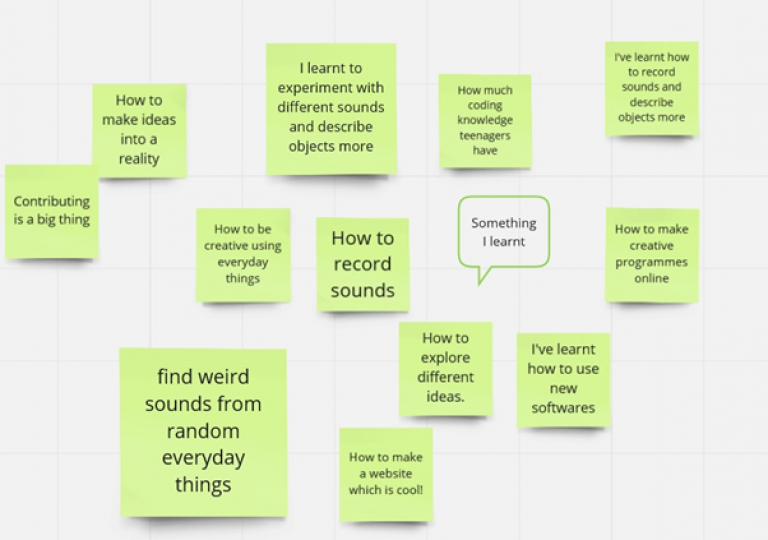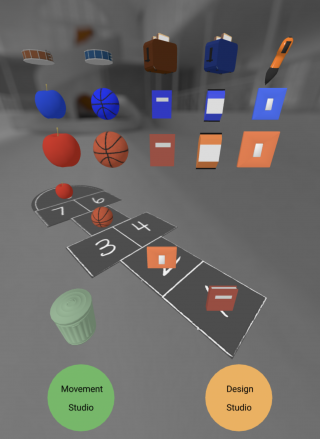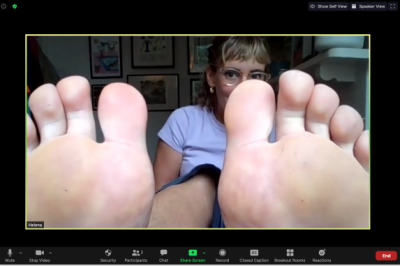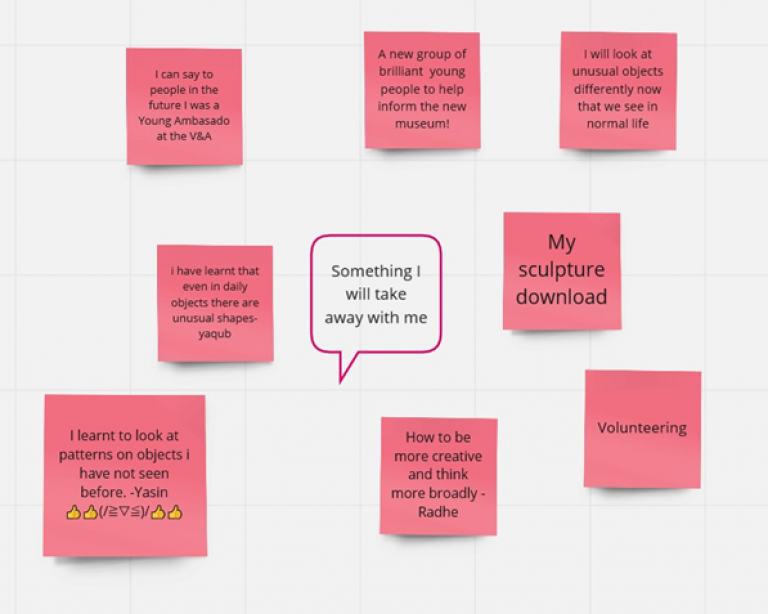Learning through doing co-creation online: RE-Invent Digital Pilot
7 January 2021
In the second blog about the RE-Invent Digital Pilot, researchers from UCL’s Connected Environments Lab share their own learning for other researchers, practitioners and youth workers who may be exploring emerging practices of digital engagement in a post-Covid world.

By Leah Lovett and Valerio Signorelli (Researchers at CASA), and Helena Rice (Senior Creative Producer at V&A Museum of Childhood)
During the pandemic, researchers from UCL’s Connected Environments Lab at the Bartlett Centre of Advanced Spatial Analysis joined together with creative producers at the Victoria and Albert Museum of Childhood for the online knowledge exchange project, RE-Invent Digital Pilot. Through close collaboration with artists, young ambassadors (11-14) and youth workers, the team co-created a series of interactive, web-based VR studios to creatively engage young people during lockdown. With the Bethnal Green-based museum closed for a major transformation project, RE-Invent Digital Pilot focussed on movement, design and sound to reflect the planned organisation of the new museum galleries. The artists commissioned for the project were Krisiti Minchin, Marawa Ibrahim and Dan Mayfield/School of Noise. The project was funded by UCL Culture and UCL East through their Listen and Respond initiative.
Previous blog posts have explored the development and context of the project and a Q&A from the audience to a public talk delivered as part of the UCL East Lunch Hour Lecture series.
Here, the team shares their own learning and feedback from project participants for other researchers, practitioners and youth workers who may be exploring emerging practices of digital engagement in a post-Covid context.

Overcoming barriers to digital engagement
The online delivery of RE-Invent Digital Pilot came about as a direct response to the pandemic and the first UK lockdown (March 2020). Connected Environments had been invited to present as part of the RE-Invent Festival planned to take place at the Museum of Childhood in May 2020. With the closure of schools, universities and cultural organisations due to Covid-19, we began to discuss the possibility of reimagining this engagement activity as a digital offering for the V&A’s ‘reach’ audience of 11-14 year olds, a move that was ultimately possible thanks to the flexibility of UCL Culture and UCL East as the project funders.
We were, however, conscious of the multiple potential barriers to engaging 11-14 year olds online. Notwithstanding the digital inclusion strategy and action plan initiated by the London Borough of Tower Hamlets, resulting in internet access for 92% of households, young people in this age group may not have use of a dedicated device. One of the main ways we attempted to overcome this issue was through partnering with Tower Hamlets youth organisations, Spotlight and Leaders in Community. The youth workers were able to extend the invitation to participate to local families through their existing networks, and they supported continuing participation through ensuring access to devices and sufficient data. They also took responsibility for safeguarding during the sessions and acted as the main point of contact for communications between the young people and the project team.
There are specific safeguarding issues that arise from Zoom as a digital portal into participants’ homes. A typical response to this problem is for participants to keep their cameras and microphones switched off to maintain their own boundaries and comfort. However, participants being present without being visible or heard can also close off potential points of access and communication. The blank screens may also pose new challenges to facilitators who are used to ‘reading the room’ during a process in assessing whether and how their ideas are landing. While there are no straightforward answers to these issues, creating a respectful environment and using chat as a way to check in can help the group to build trust over time.
Connected to this, another challenge was around how to sustain participation for the duration of the project, particularly amidst the uncertainty of the pandemic. RE-Invent Digital Pilot took place over several months (from April-October 2020), with welcome sessions, six creative workshops (two facilitated by each of the three project artists), Beta testing sessions and a launch event. A total of 19 young people, youth workers, creative producers and researchers joined these sessions. However, occasionally there were two or three young people on any single call, and one workshop had to be rescheduled due to non-attendance.
Maintaining the momentum of the project required us to be flexible in how we imagined and invited participation. We shared a session outline with the youth workers before each workshop, with questions and details of activities planned for the session to be sent on to the participants. This enabled some young people to contribute even if they weren’t able to attend a particular session. The youth workers also followed up with participants after workshops to encourage them to send images, sounds and drawings to inform the artists in developing their digital commissions. After each session, Helena added to a visual journal, which gave everyone involved a view of the shape and progress of the project.
Novel uses for familiar platforms
In developing the RE-Invent Digital Pilot, the use of web-based augmented reality (AR) tools enabled the researchers to respond rapidly to implement suggestions from co-creators, and also ensured the accessibility of the final app across iOS and Android operating systems. The decision to optimise the app for mobile devices reflects the means by which the majority of young people participated in the workshops. However, the workshops themselves took place using Zoom, as the preferred platform of the partner youth organisations and young people. During later sessions, a Miro board was used to capture feedback from the project participants. A WhatsApp group set up by the youth workers for the young people enabled them to send reminders, share the workshop outlines and activities, and receive creative contributions from the young people before sending them on to the rest of the team. There was no direct communication between the young people, researchers, producers and artists outside of the workshops.
An immediate practical challenge in using Zoom as a collaborative tool is that it tends to encourage more sedentary modes of engagement. Creative workshops with children are usually highly active, especially when working with movement-based practices. The workshops delivered as part of RE-Invent Digital Pilot included movement (Marawa Ibrahim), sculpture (Kristi Minchin), and sound recording (Dan Mayfield/School of Noise). Dan found ways to record sounds through Zoom and create new audio materials live in the call. Marawa invited us to remove our shoes and socks and bring our toes into frame. Kristi’s session asked us to use objects from around the home to create something new, to look harder at those things and seek inspiration from them. We were initially concerned that some of these activities might feel forced or embarrassing. Actually, they felt like a welcome and positive choice, particularly during such a sedentary period. The move away from seating felt big and brave – so much more than in a face-to-face session. The moments of direct, movement-based interaction actively enabled a process of co-creation to begin.

In early sessions, particularly when attendance was a problem, we noticed that the adult-child ratio was putting pressure on the young people, potentially reducing their access and input. After some discussion, we began using breakout rooms as a way to counteract this imbalance. The artist, youth worker and young people would break off from the main group for the creative activity, before returning to the room to share back ideas and creations to the facilitators and researchers at UCL and V&A. As well as creating a more intimate space for tentative ideas to develop, this simple shift helped to punctuate and set the pace for more engaging sessions.
Towards the end of the project, we used the visual collaboration tool, Miro, as a way for the young people to anonymously record their experiences of participating in the project and their responses to the RE-Invent Digital app. Though more often used in office settings for project planning, the blank canvas and post-it note format proved to be extremely popular with our participants. Given the opportunity again, we would create a live Miro board at the outset of similar digital co-creation projects to act as an accessible notice board for sharing and developing ideas.

Reflections on co-creation
RE-Invent Digital Pilot invited collaboration from artist practitioners during a period when many creative opportunities were disappearing due to the pandemic. As a consequence, the project also became an experimental space for the commissioned artists to adapt their practice to digital engagement with audiences.
"This has been a solid process of that – workshopping then executing it right through to the end... Like the blue-print of how these things can work, and how we can apply our skills and share them differently online." (Marawa Ibrahim, project artist)
One of the key aims of this project was to explore opportunities for co-creating digital interactive experiences online from concept through to completion. Our starting position was that every participant had a meaningful contribution to make in developing RE-Invent Digital, and that our role as researchers and producers was to listen.
"Making them [the young people] part of the process was crucial to it, not tokenistic. For me, making something, having time to see a project all the way through felt important. So often, I’m just doing the one hour workshop thing and then leaving. This was a chance to concentrate on one thing and then finish it and now it’s a tool people can use." (Dan Mayfield, project artist)
When we shared the Beta version of the app with the young ambassadors and their critical friends, they had many ideas on how we could change, grow and alter the platform. These suggestions ranged from granular, functional changes, to removing double taps, to adding ongoing updates to keep users engaged. Above all, this feedback reflected the power of co-creation as a model for witnessing the impact of their contributions:
"I learnt how to make ideas into a reality." (Young Ambassador)
"I learnt that contributing is a big thing." (Young Ambassador)
Final thoughts
The RE-Invent Digital Pilot project showed us that a sense of community can form remotely. The project provided participants with a shared purpose, despite the multiple barriers to digital engagement and participation during a health crisis. In the context of lockdown, we found the young people who participated were also seeking opportunities for connecting with peers. While in many ways an imperfect tool, Zoom provided a space for meaningful conversations between the young participants, researchers, producers and youth workers to occur.
The group’s shared identity was further strengthened through the creation of the role of Young Ambassador for the V&A Museum of Childhood. As Young Ambassadors, the participants will continue to contribute to the development of the reimagined museum in Bethnal Green, thereby building on the discoveries from the RE-Invent Digital Pilot project and ensuring its legacy. Likewise, the commissioned artists who participated in this digital experiment have informed the way the V&A Museum of Childhood collaborate with creatives moving forward. One of the artists has, since this project, worked with the families team at the museum to create digital content in relation to a new gallery for younger audiences at home.
As researchers and creative producers, we have tested the limits and opportunities for iterative co-creation remote from participants and the space we are exploring, an entirely new process for all of us.
 Close
Close

